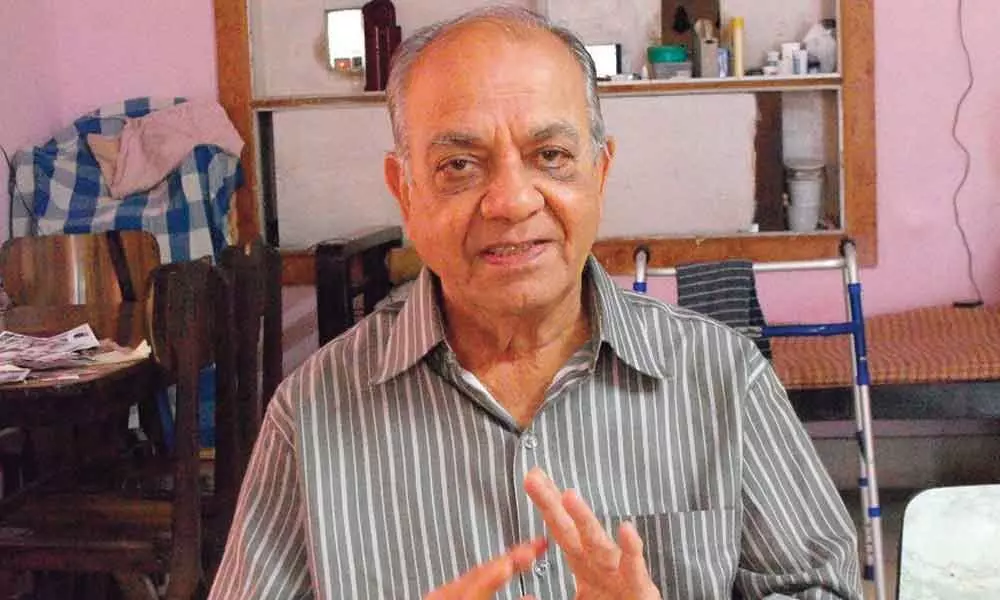Live
- Waltair Division observes ‘Energy Conservation Week’
- Srikakulam police bust two fake note gangs
- 3 held, 810 kg ganja seized
- Workshop on ‘Live Agri-technologies’ concludes at SPMVV
- Advancing Biomedical Research with NMR techniques
- Key Highlights of India in 2024
- Expose Opposition’s evil propaganda in villages: Seethakka to Cong workers
- MLA Sudhir focuses on amenities at Srikalahasti rly station
- Chittoor police crack down on drunk driving with 963 cases
- Vision document historical, says Keshav
Just In

Amardas Hinduja
Through his lens, veteran photographer Amardas had documented around 62 Dasara celebrations
Mysuru: Veteran freelance photojournalist Amardas Hinduja, 83, who had covered more than 62 Dasara celebrations and private 'darbars' of three Mysuru Maharajas, breathed his last at his residence at Hebbal in Mysuru on Saturday night.
Amardas had moved to Mumbai from West Pakistan during 1947 partition. A diploma holder in photography from St Xavier's College in Mumbai, he was trained at the famous Raj Kapoor's studio in Mumbai. He had moved to Mysuru to shoot a Raj Kapoor's movie in Premier Studio in 1957 and lived in Mysuru since.
Through his lens, Amardas had documented the Dasara celebrations and photographed several important dignitaries, including the country's first prime minister Jawaharlal Nehru in 1958. "Nehru was fascinated at the view of Brindavan Gardens. He had said he had never seen such a thing in life," he had said.
During his career spanning more than three decades, he had covered 62 Dasara celebrations and private 'darbars' at Mysuru Palace during the reign of last Maharaja of Mysuru, Sri Jayachachamaraja Wadiyar, before the privy purse, was abolished in 1971. He later covered the event during the period of 26th scion of erstwhile royal family late Srikantadatta Narasimharaja Wadiyar and the present scion Sri Yaduveer Krishnadatta Chamaraja Wadiyar.
"Sri Jayachamaraja Wadiyar was the last maharaja who sat inside 750kg golden howdah which was carried by a 12-feet tall elephant 'Biligiri' during the Dasara 'Jumbo Savari' procession in 1969-70. It was a class Dasara then. It was everybody's festival. The city was decorated like a new bride. Dignitaries various countries, including France, Germany and England were invited for the celebrations. The dignitaries were housed at Hotel Metropole of Mysuru, and chefs were brought from various countries. I received an invitation from the Maharaja to attend private darbar at the Mysuru Palace during Dasara time. There used to be a dress code to attend private darbar. There were separate galleries for children, women, and Europeans to attend the darbar. Europeans were expected to come in a suit and a tie. Civilians had to wear a long coat, 'Valli', and a turban. Those costumes were available on rent in certain studios in Mysuru and at Mysore Palace board," Amardas had recalled.
The entire stretch used to be covered with white sand and the horses' shoes used to be nailed so that the friction created a musical sound when they walked. There was never tableaux or cultural troupes in the procession. Three infantries, three Cavalries of Mysore Palace, troupes of the Hyderabad Nizam's Military, and Madras Engineering Group took part in the procession, he reminisced. "Maharaja used to begin his journey in the golden howdah at the end of the procession. The procession used to take three-and-a-half hours to reach Bannimantap covering 4.8 km. People used to come from neighboring villages in bullock carts and sleep on Mysuru streets overnight to watch mainly to see Maharaja who was considered no less than a God during those times," he recalled.
Deeply painted at the missing royal days of the yore, Amaradas turned poetical albeit in Hindi, 'Na Raja rahega, na Rani rahegi ye maati sabhi ki kahaani kahegi'. Booli hoove yaade, ithna na sathaavo chain se rehne do mere paas na aavo."
Amardas is survived by his wife Ashada, son Nithin, daughters Preethi and Jyothi. He was cremated at the crematorium at Vijayanagar in Mysuru on Sunday afternoon.

© 2024 Hyderabad Media House Limited/The Hans India. All rights reserved. Powered by hocalwire.com







